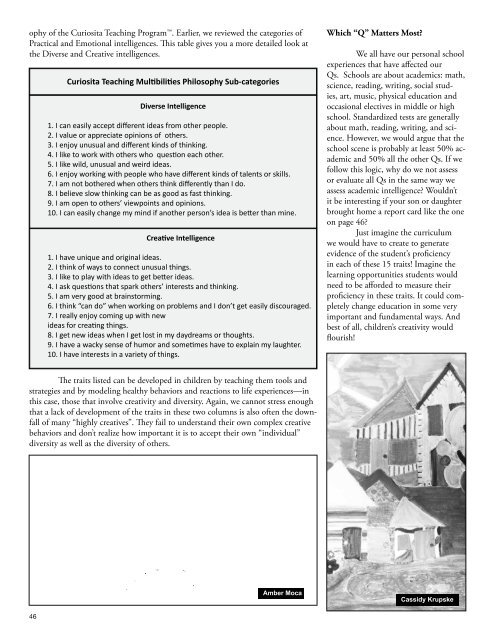Torrance Journal for Applied Creativity
TorranceJournal_V1
TorranceJournal_V1
Create successful ePaper yourself
Turn your PDF publications into a flip-book with our unique Google optimized e-Paper software.
ophy of the Curiosita Teaching Program. Earlier, we reviewed the categories of<br />
Practical and Emotional intelligences. This table gives you a more detailed look at<br />
the Diverse and Creative intelligences.<br />
Curiosita Teaching Multibilities Philosophy Sub-categories<br />
Diverse Intelligence<br />
1. I can easily accept different ideas from other people.<br />
2. I value or appreciate opinions of others.<br />
3. I enjoy unusual and different kinds of thinking.<br />
4. I like to work with others who question each other.<br />
5. I like wild, unusual and weird ideas.<br />
6. I enjoy working with people who have different kinds of talents or skills.<br />
7. I am not bothered when others think differently than I do.<br />
8. I believe slow thinking can be as good as fast thinking.<br />
9. I am open to others’ viewpoints and opinions.<br />
10. I can easily change my mind if another person’s idea is better than mine.<br />
Creative Intelligence<br />
1. I have unique and original ideas.<br />
2. I think of ways to connect unusual things.<br />
3. I like to play with ideas to get better ideas.<br />
4. I ask questions that spark others’ interests and thinking.<br />
5. I am very good at brainstorming.<br />
6. I think “can do” when working on problems and I don’t get easily discouraged.<br />
7. I really enjoy coming up with new<br />
ideas <strong>for</strong> creating things.<br />
8. I get new ideas when I get lost in my daydreams or thoughts.<br />
9. I have a wacky sense of humor and sometimes have to explain my laughter.<br />
10. I have interests in a variety of things.<br />
Which “Q” Matters Most?<br />
We all have our personal school<br />
experiences that have affected our<br />
Qs. Schools are about academics: math,<br />
science, reading, writing, social studies,<br />
art, music, physical education and<br />
occasional electives in middle or high<br />
school. Standardized tests are generally<br />
about math, reading, writing, and science.<br />
However, we would argue that the<br />
school scene is probably at least 50% academic<br />
and 50% all the other Qs. If we<br />
follow this logic, why do we not assess<br />
or evaluate all Qs in the same way we<br />
assess academic intelligence? Wouldn’t<br />
it be interesting if your son or daughter<br />
brought home a report card like the one<br />
on page 46?<br />
Just imagine the curriculum<br />
we would have to create to generate<br />
evidence of the student’s proficiency<br />
in each of these 15 traits! Imagine the<br />
learning opportunities students would<br />
need to be af<strong>for</strong>ded to measure their<br />
proficiency in these traits. It could completely<br />
change education in some very<br />
important and fundamental ways. And<br />
best of all, children’s creativity would<br />
flourish!<br />
The traits listed can be developed in children by teaching them tools and<br />
strategies and by modeling healthy behaviors and reactions to life experiences—in<br />
this case, those that involve creativity and diversity. Again, we cannot stress enough<br />
that a lack of development of the traits in these two columns is also often the downfall<br />
of many “highly creatives”. They fail to understand their own complex creative<br />
behaviors and don’t realize how important it is to accept their own “individual”<br />
diversity as well as the diversity of others.<br />
Amber Moca<br />
Cassidy Krupske<br />
46


